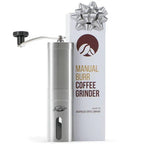Making delicious pour over coffee often seems like more effort than it’s worth. It’s very hands-on, you have to pour water a specific way, and it all seems a little ‘woo-woo’. Except, it’s so worth it.
There’s just something about enjoying an amazing mug of coffee made by your own hand.
But to get to that point, you really need to learn the water pouring technique. It’s easy to delve into pseudoscience and guessing when talking about the water pouring process, but there’s actually a decent amount of hard science that you can use to develop an understanding of the technique. Once again, worth it.
Here’s what the technique offers…
- A more balanced extraction and flavor
- Richer, more ‘clean’ flavors
Use bad technique (or no technique at all) and your coffee will likely end up imbalanced, being either too bitter or too sour. And that’s no way to drink coffee.
Read: Is Pour Over Coffee Brewing Worth The Effort?
Learn the technique. Practice the technique. Brew better coffee.
Why Pour Over Coffee Even Requires A Technique
With immersion brewing, like with a french press, the coffee grounds and water sit together for minutes, enabling a pretty straightforward extraction. Pour over coffee is different—the water’s constantly draining.
This always-draining design constantly replenishes draining brewed coffee with new, fresh water. This speeds up the process and usually produces coffee with a ‘cleaner’ flavor, but it also creates a problem that’s almost certain to arise naturally.
Without proper technique, the water will create ‘channels’ through the grounds. While draining, the water will always look for the path of least resistance. Essentially, when a path is paved through the grounds, the water’s more likely to just follow it, thanks to our good friend Gravity.
The grounds along these channels will experience over extraction, while the grounds in more dry areas of the coffee bed will not be extracted from enough. This creates an imbalanced brew that’s both bitter and sour. This is why you can’t just fill a dripper with water and let it drain on its own. It will naturally produce channels.
Read: 5 Common Beginner Pour Over Coffee Questions Answered
Here’s the only way to fix this: pour in a way that saturates all the grounds. And how do you do this? By pouring a slow, steady stream of water in circles over the coffee bed.
Let’s look at exactly how to accomplish this.
Tools Needed To Master The Technique
Unfortunately, the precise that’s required to pour water well can’t be achieved with the average kettle. Instead, I strongly suggest investing in a gooseneck kettle (specially designed for pour over coffee).
These kettles have a thin, long pouring spout that slows down the flow of water and gives you a high degree of control over the speed and placement of your pour. Without a gooseneck kettle, you’ll have to fight a large spouted kettle that can’t pour smoothly and consistently to save its life—and with this kind of brewing, consistency is everything.
Read: 3 Reasons You Need A Coffee Scale To Brew Coffee
There’s a second piece of gear that makes mastering this technique a lot easier: a coffee scale. Any kitchen scale that can read grams without much delay will work.
A scale gives you real-time updates as to exactly how much water you’ve poured and how fast it’s coming out. This can improve your consistency dramatically, because without a scale you’re just winging it, which tends to leave a lot of room for error.
If you had to pick just one, get the pour over kettle.

Mastering Your Pour Over Coffee Technique
Let’s now take a look at the specific technique that experienced coffee brewers use while making pour over coffee. Up first, the bloom phase.
Read: The Ultimate Guide to Pour Over Coffee
The Bloom
This initial coffee and water contact initiates a variety of physical and chemical changes in the grounds that prepare them for brewing, so it’s important that you hit all the grounds. A big event here is the rapid release of CO2 gas. The gas is coming out so powerfully that the grounds won’t absorb the water very quickly, which is why we even have this stage.
Pour twice the amount of water as there is coffee in grams. For example, if you’re using 20g of coffee, pour in 40g (or 40ml, same thing) of water.
You want to pour very slowly in controlled circles. Start at the center and make your way to the edges, hitting all the grounds evenly. Now you wait, usually for 20-30 seconds.
The Main Pouring
Once the bloom phase is complete, it’s time to start pouring again. Here’s what you need to keep in mind.
- Slow, concentric circles. Start in the center and pour slow circles. Move in and out to keep saturating all the grounds.
- The center of the coffee bed is the deepest. There are more grounds in the center (because of the cone shape), so you should find yourself pouring more in the middle than on the sides while doing your slow circles.
Read: The Easy Guide To Cleaning Your JavaPresse Pour Over Dripper
- Don’t hit the sides. Water that hits the sides of the brewer is more likely to run down the wall of the filter and not actually through the coffee. Since it’s hard to control extraction when this happens, just don’t do it.
- Keep a steady arm. If you’re slinging around the kettle at each turn, one side of the coffee bed will be bombarded with extra-forceful water than the other. Gentle, slow movements keep the water falling onto the coffee, not driving into the coffee.
- Watch the scale and recognize patterns. After a few pours, try to find repeatable milestones you can rely on to let you know how it’s going. For example, pouring 150g by the 1:30 mark. You can then use that checkpoint to help you know if you need to speed up or slow down.
The Final Moments
The last 15 seconds of your pour should be in the very center of the coffee bed. Once again, this is because there’s actually more coffee in the middle than on the sides because of the cone shape.
However, for the final 1-2 seconds, you’re not going to pour in the center. You’re going to do something called ‘rinsing the sides’.
Read: Making Iced Pour Over Coffee With The JavaPresse Dripper
Using as little water as possible, direct the stream to the sides of the filter and give the the coffee clinging there a quick rinse. This detaches stuck grounds and allows them to lower as the water drains.
The reason we often do this is to avoid ‘high and dry grounds’. These are grounds that get stuck on the sides of the filter and don’t stay saturated as the water drains. These grounds end up less extracted than the rest, which results in imbalance. Rinsing the sides helps all the grounds drain and brew evenly.

What Should The Final Coffee Bed Look Like?
When all the coffee is drained, you should be able to see a flat bed of grounds resting evenly at the bottom of the cone. This indicates that all the grounds were evenly distributed and able to drain collectively.
Read: 5 Things Every Pour Over Coffee Lover Should Know
Here’s what you don’t want.
- Volcano Sides — If you end up with a giant tunnel going straight down and all the grounds packed onto the sides, you probably brewed a slightly imbalanced cup. Those upper grounds were extracted from less than the lower grounds. To fix, rinse the sides and don’t pour quite as much in the center.
- Uneven Bed — If one side of the coffee ground bed is more elevated than the other, that indicates you didn’t pour water with the same strength on all sides of the coffee bed. To fix, make sure you’re pouring gently and not forcing water into one side with more energy than the other.
A flat, level bed is the goal—and with it comes balanced, delicious coffee.
---
As you can see, technique matters. There’s a noticeable difference in flavor when it comes to pour over coffee brewed with and without technique.
Of course, if you’re using freshly roasted, specialty-grade beans, the whole process will be a little more forgiving since the coffee’s of such high quality.


